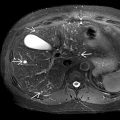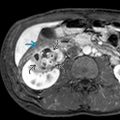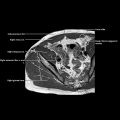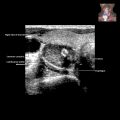KEY FACTS
Terminology
- •
Cerebrospinal fluid collection enclosed within layers of arachnoid membrane (i.e., extraaxial location inside skull but outside brain)
Imaging
- •
Usually single, extraaxial, thin walled, smoothly marginated, avascular, anechoic
- ○
2/3 supratentorial (i.e., adjacent to cerebral hemispheres)
- ○
1/3 in posterior fossa (i.e., adjacent to cerebellum)
- ○
- •
Exerts mass effect displacing adjacent brain parenchyma or major cerebral vessels
- •
Underlying brain sonographically normal in majority of cases, but adjacent calvarium may be thinned, scalloped
Top Differential Diagnoses
- •
Porencephalic cyst: Replaces destroyed brain
- •
Schizencephaly
- ○
Cleft in brain substance, wedge-shaped rather than round, absent cavum
- ○
- •
Interhemispheric cyst/AVID
- ○
A symmetric v entriculomegaly with i nterhemispheric cyst and d ysgenesis of corpus callosum
- ○
- •
Dandy-Walker malformation
- ○
Posterior fossa cyst in continuity with 4th ventricle
- ○
Scanning Tips
- •
Always check Doppler in apparent cyst to rule out vascular malformation
- ○
Vascular lesions have worse prognosis
- ○
- •
Monitor for growth of cyst (occurs in ~ 20% of cases)
- ○
Rarely, may exhibit rapid growth and cause obstructive hydrocephalus
- ○
- •
Look for other abnormalities
- ○
Prognosis good if isolated abnormality
- ○
- •
> 90% discovered after 20-weeks gestation
 and displaces and compresses underlying normal brain. If large, the cyst may cause shift of vessels &/or the midline structures
and displaces and compresses underlying normal brain. If large, the cyst may cause shift of vessels &/or the midline structures  .
.










